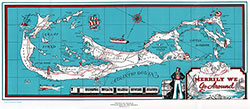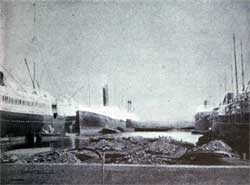Ports of Call for Steamships and Ocean Liners
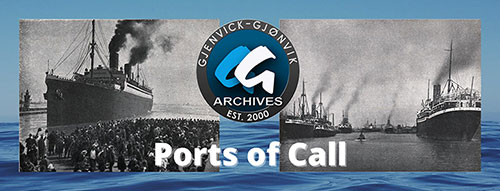
The Ports of Call of the many steamship lines have varied histories and backgrounds. They operated much like the hub and spoke system of the World Airlines of today. Smaller ports were often unable to accommodate the largest steamships but handled the valuable traffic from feeder lines that brought many immigrants to the major ports.
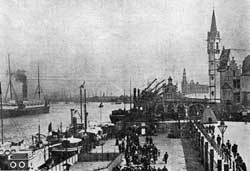
Antwerp harbor is unique, lying about fifty miles from the North Sea, on the right bank of the river Scheldt, at the crossing of the most important maritime route and the densest and most extensive net of rivers, canals and railroads.
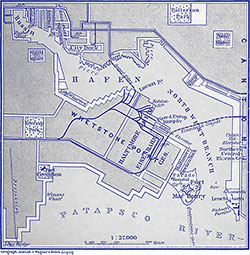
A portion of the water front thus included lies outside of the municipal limits, but the State legislature has by law extended the jurisdiction of the Bureau of Harbors of Baltimore city to include the entire river and its tributaries.
The Bermudas, or Bermuda as this group is known today, is the world's most northerly group of coral islands, situated in a southeasterly direction, 666 miles from New York, 568 miles from Cape Hatteras, and 720 miles from Halifax.

Boston offers to steamship lines serving the United States exceptional inducements to bring their through immigrant passengers via Boston. Photographs, Maps, Articles and Information on the History of the Port of Boston and Immigration and usage by Steamships.
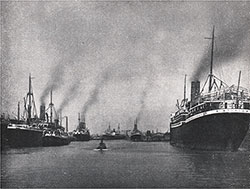
Bremerhaven, a port on the Weser, near 10 miles from its mouth, was founded by Bremen in 1827 on ground acquired from Hanover, and soon became a thriving place. It has extensive docks and quays, and may be regarded as the seaport of Bremen.
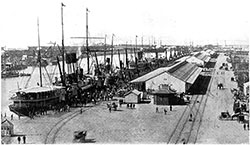
Port of Buenos Aires, Argentina
Buenos Aires is the capital and largest city of Argentina, and the second-largest metropolitan area in South America. The Port of Buenos Aires is the principal maritime port in Argentina.
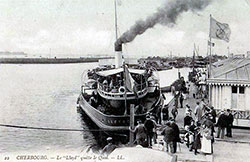
Cherbourg has attained a position of importance as a port of call for transatlantic liners because of its 40-mile proximity to the routes followed by vessels plying between North and South American ports and Southampton or between North and South American ports and North European ports via Plymouth or Cobh.
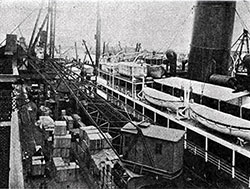
Situated on the highway of traffic from the Atlantic to the Baltic, Copenhagen is the foremost port of transshipment for the trade from America to the Baltic countries and the home port of the Scandinavian-American Line.
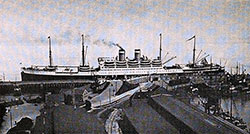
The port of Cuxhaven, which lies on the south bank at the mouth of the Elbe about 64 miles below Hamburg, comprises a considerable part of the Ritzebuettel district, a detached part of the Free State of Hamburg.
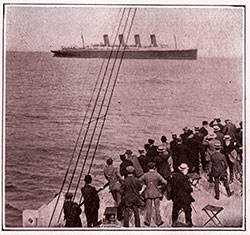
Fishguard is situated on the southwest coast of Wales, and is the nearest British port to New York used by Atlantic liners. It affords the quickest means of reaching London, and is also a convenient port for the Continent.
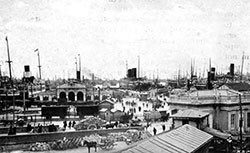
The approach to Genoa, from either Naples or the western Mediterranean, is in sight of noble shores. Arriving from the West the course is along the French Riviera, with the bold cliffs and famous cities and the Maritime Alps in full sight.
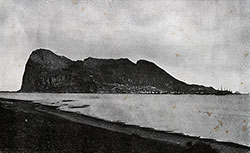
Nearing the Strait of Gibraltar, the vessel crossing the Atlantic first sights the bold cliff shores of Cape St. Vincent in the southwest corner of Portugal. Lighthouse and signal stations here are plainly seen.
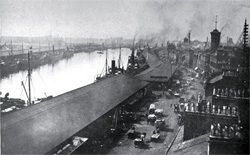
Today, the quayage of Glasgow is over ten miles in length, sufficient to berth forty or fifty ocean vessels at a time, and the total area of the harbor and docks includes over 181 acres of water.
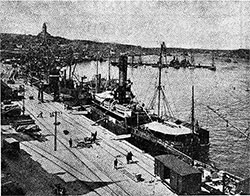
The Gothenburg Free Port has a total pier frontage of 3.640 feet with 30 feet of water alongside. A concrete warehouse of five stories. and several enclosed sheds have been built for the storage and parceling of goods.
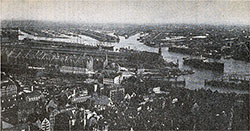
Hamburg is, by far, the most important port in the German Republic. Its yearly commerce is slightly in excess of the combined total traffic of all other German seaports. Its trade is not only greater in volume and value but it is also more diversified and widespread than that of any domestic rival.
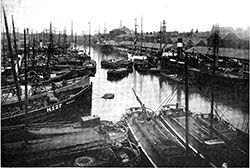
Hull's right to be numbered among the great seaports of the world does not rest simply upon its present preeminence as a shipping port. It has older claims to the distinction.
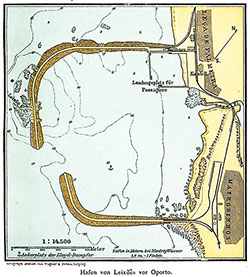
Leixões is one of Portugal's major seaports, located 4 km north of the mouth of the Douro River, in Matosinhos municipality, near the city of Porto.
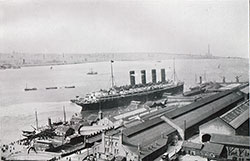
During the latter half of the 19th century Liverpool became Britain's No 1 port for passengers wishing to travel to America, and earned for itself the soubriquet The Gateway to the West'.
The Port of London consists of the river Thames from the sea to the outskirts of the Metropolis, with enormous areas devoted to various docks, besides Wharves, warehouses, and factories which line the river for mile on mile.
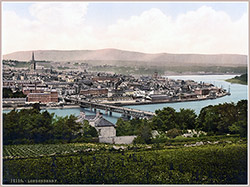
Port of Londonderry, Northern Ireland
Londonderry Port is a port at Lisahally in County Londonderry, Northern Ireland. The United Kingdom’s most westerly port, it has capacity for 30,000-ton vessels and accepts cruise ships.
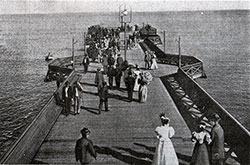
Montevideo is the capital and largest city of Uruguay. Situated on the north shore of the Río de la Plata, the port sits on the arm of the Atlantic Ocean that separates the south coast of Uruguay from the north coast of Argentina.
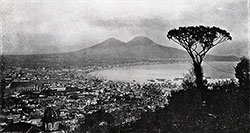
Vessels entering the Bay of Naples pass close to the mountain island of Ischia on the left of the route. Testaccio and Barano above are particularly noticeable towns on the slopes of the hills leading up to Mount Epomeo, which tops the scene.
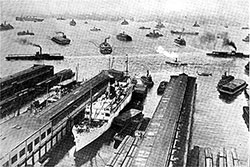
New York Harbor - Pre World War II
The geographical conditions which themselves made New York the logical gateway of this country by reason of its great expanse of waterfront, its favorable tide conditions, its deep channels and its ready access to the ocean, caused a. growth that has no parallel in history.
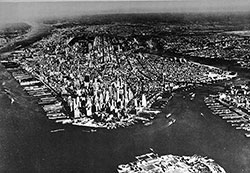
New York Harbor - Post World War II
New York City is located in the southeastern part of New York State and is the focal point of the Port of New York. The port includes a waterfrontage of 755 miles measured along the shoreline of its many bays, rivers, and indentations within the port district.
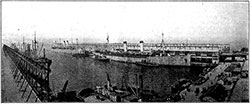
Already the world's greatest coaling port, Norfolk attracted conspicuous attention in 1920 by doubling its exports, and increasing its imports five-fold.
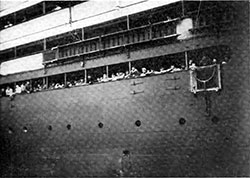
Plymouth - Its advantage as a landing place and the attractiveness of the surrounding country, rapidly becoming the most important recreation ground in England, are bringing to it a degree of prominence in American thought scarcely second to that which Southampton has attained.
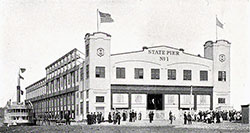
Port of Providence, Rhode Island
Steamship Lines at Present Using the Port of Providence Regularly include Fabre Line, to Naples, Marseilles, Cape Verde Islands and New York; Colonial Navigation Company, to New York; Hartford and New York Transportation Company, to New York; and others.
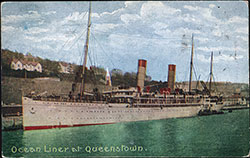
For American travelers making their first visit to the British Islands, and wishful to see some of the beauties of the Emerald Isle, a good plan is to land at Queenstown and proceed through Glengariff to the far-famed Lakes of Killarney.
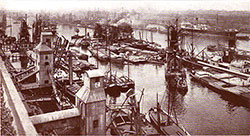
Rotterdam is, par excellence, a "transit port." It is one of the main gates of entrance to and egress from the interior of Europe and an entrepot or transshipping station for the merchandise of the world.
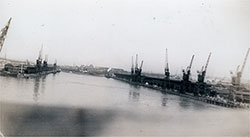
The Southampton docks, 78 miles from London, owned and managed by the London and South Western Railway Company, are situated within a perfectly sheltered harbor, one of the best lighted in the United Kingdom, making the docks as accessible by night as by day.
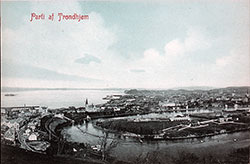
Trondhjem is built on the Trondhjem fiord, and occupies the delta formed by the river Nid, with suburbs extending up the surrounding hills. With its 40,000 inhabitants it is the third town in Norway in point of size. (1906)

